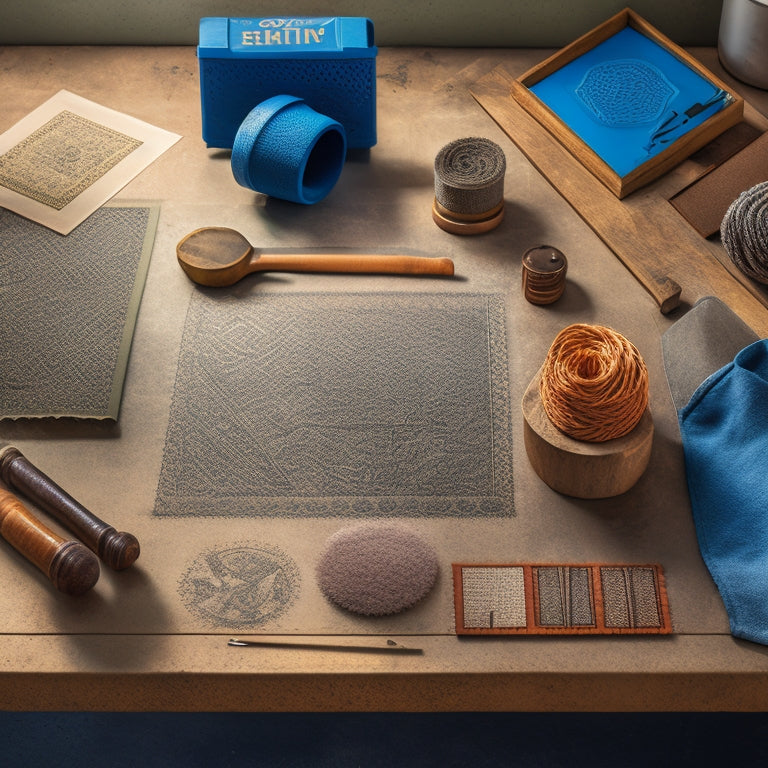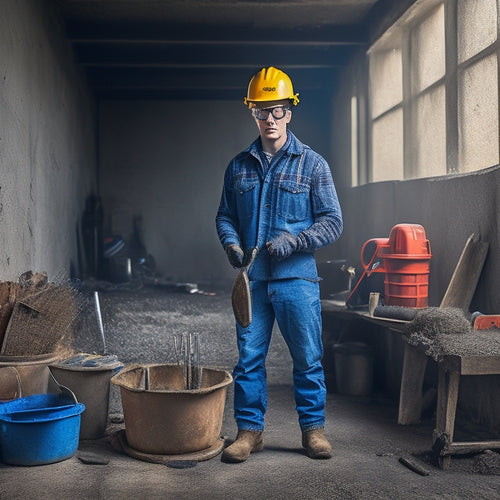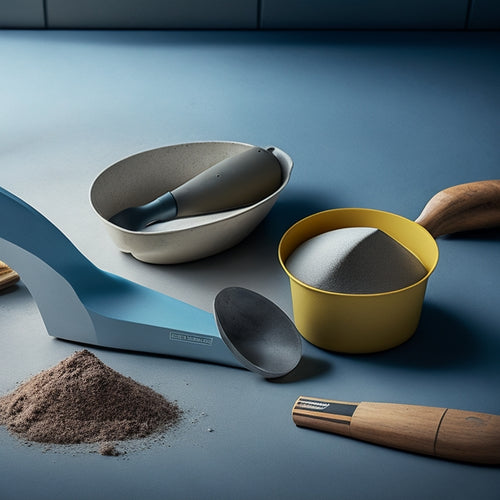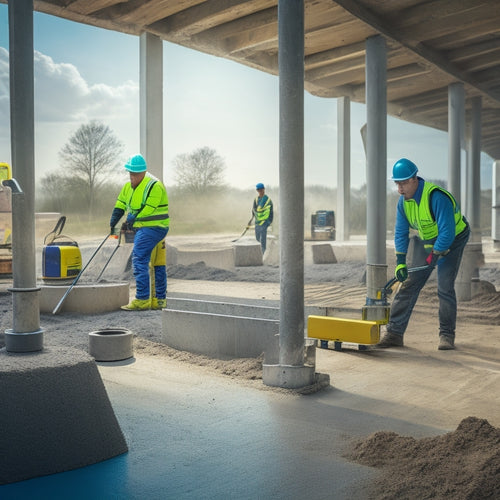
5 Best Tools for Stamping Concrete Walls
Share
When it comes to stamping concrete walls, you'll need a range of specialized tools to achieve the desired texture and pattern. Start with essential stamping tools like hand tampers, touch-up tools, and release agents to guarantee a precise impression. Concrete stampers and tampers come in various designs to achieve different textures and patterns, from rough to embossed finishes. Don't forget color and sealant applicators, such as HVLP sprayers and rollers, to enhance the aesthetic appeal and durability of your design. Finally, edging and finishing tools like edgers, jointers, and finishing trowels will give your project a professional-looking finish. There's more to investigate in the world of stamped concrete walls, and the right tools are just the beginning.
Key Takeaways
- Hand tampers and touch-up tools are essential for pressing patterns into concrete and refining edges for a professional finish.
- Selecting the right texture mat is crucial for achieving the desired aesthetic, with options including smooth, rough, and embossed finishes.
- Concrete stampers and tampers come in a variety, and selection should be based on desired design and concrete surface preparation.
- Release agents are necessary to prevent sticking of stamping tools to concrete, and durable materials like steel or high-quality polymers are recommended.
- Edging and finishing tools, such as edgers and jointers, are key for creating clean, defined edges and a consistent, even finish.
Texture Mats and Patterns
As you prepare to stamp your concrete walls, selecting the right texture mats and patterns is vital to achieving the desired aesthetic.
You'll want to take into account the various texture variations available, including smooth, rough, and embossed finishes. Each texture variation can dramatically alter the appearance of your stamped concrete, so it's imperative to choose the one that best fits your design vision.
When it comes to pattern selection, you'll have a range of options to choose from, including brick, stone, and wood patterns.
Reflect on the design style of your building, as well as the surrounding environment, to determine which pattern will blend in seamlessly. Some patterns, such as ashlar and herringbone, offer a more subtle, understated look, while others, like running bond and hexagon, make a bold statement.
Stamping Tools and Accessories
With your texture mats and patterns in place, you're now ready to focus on the tools and accessories that will bring your stamped concrete walls to life. These tools play an essential role in enhancing the realism and durability of your stamping techniques.
You'll need a set of quality stamping tools, including hand tampers, touch-up tools, and release agents. Hand tampers are used to press the pattern into the concrete, while touch-up tools help refine the edges and details. Release agents, such as powdered or liquid releases, prevent the stamping tools from sticking to the concrete.
When selecting stamping tools and accessories, material selection is vital. Look for tools made from durable materials, such as steel or high-quality polymers, that can withstand the rigors of stamping concrete.
Additionally, consider the specific stamping techniques you'll be using, as some tools are designed for specific patterns or textures. By choosing the right tools and accessories, you'll be able to achieve professional-looking results and guarantee the longevity of your stamped concrete walls.
Concrete Stampers and Tampers
Several concrete stampers and tampers are available to help you achieve the desired texture and pattern on your stamped concrete walls. When selecting a stamper, consider the design you want to accomplish and the concrete surface preparation required.
For instance, if you're aiming for a textured, stone-like appearance, you'll need a stamper with a deeper impression pattern. On the other hand, if you're going for a more subtle, intricate design, a stamper with a shallower impression pattern will suffice.
Stamp design selection is also essential, as it will determine the final appearance of your stamped concrete walls. You can choose from a variety of stamp designs, including brick, stone, and wood patterns. Some stampers come with interchangeable stamp designs, allowing you to experiment with different patterns and textures.
Tampers, on the other hand, are used to compact and flatten the concrete after stamping. They help remove air pockets and guarantee a smooth, even finish.
When using a tamper, be sure to apply gentle, consistent pressure to avoid damaging the concrete surface. By combining the right stamper and tamper, you can achieve professional-looking results and add visual interest to your concrete walls.
Color and Sealant Applicators
Concrete color and sealant applicators play an essential role in enhancing the aesthetic appeal and durability of your stamped concrete walls.
When selecting a color applicator, you'll want to take into account the type of color you're using, as different tools are suited for different color application techniques. For example, a high-volume, low-pressure (HVLP) sprayer is ideal for applying acetone-based stains, while a roller or brush may be better suited for water-based stains.
When it comes to sealant applicators, you'll want to verify you're using a tool that provides an even, consistent application. This is critical, as uneven sealant application can compromise the durability of your stamped concrete walls.
You should also conduct regular sealant durability testing to verify the product you're using meets your project's requirements. Look for applicators with adjustable flow rates and fan patterns to achieve the desired finish.
Additionally, take into account using an applicator with a built-in filter to prevent clogs and verify a smooth application. By selecting the right color and sealant applicators, you can achieve a professional-looking finish that will last for years to come.
Edging and Finishing Tools
Three key edging and finishing tools are essential to achieving a high-quality, professional-looking finish on your stamped concrete walls.
You'll need an edger, a jointer, and a finishing trowel to create crisp edge profiles and smooth surfaces.
The edger is used to create clean, defined edges along walls, columns, and other vertical surfaces. Its curved or angled blade helps you achieve precise control and flexibility when working around corners and curves.
For a seamless joint, use a jointer to fill and finish the gap between the stamped concrete and adjacent surfaces like floors, ceilings, or other walls. This tool guarantees a consistent, even finish that's free of unsightly gaps or unevenness.
Frequently Asked Questions
Can I Stamp Concrete Walls With a Textured Finish Already Applied?
You can't stamp concrete walls with a textured finish already applied, as it'll hinder achieving crisp stamped designs; instead, guarantee proper wall preparation by removing existing textures and starting with a smooth, even surface.
How Do I Fix Air Bubbles in Freshly Stamped Concrete Walls?
When you notice air bubbles in freshly stamped concrete walls, you'll need to act fast for effective bubble repair. Start by stopping all stamping operations, then gently scrape off excess material, and re-apply a fresh layer after proper surface preparation to guarantee a smooth finish.
Is It Necessary to Prime Concrete Walls Before Stamping?
You're likely aware that 80% of concrete failures are due to inadequate surface preparation. When stamping, priming concrete walls is essential as it guarantees a strong bond, reduces delamination, and enhances durability, making surface preparation a vital step that shouldn't be skipped.
Can I Use Regular Concrete Mix for Stamping Concrete Walls?
When you're planning to use stamping techniques on concrete walls, you'll need a specialized mix that adheres well to the wall surface; regular concrete mix won't provide the necessary bonding strength, so it is crucial to choose a mix specifically designed for concrete preparation.
How Long Does It Take for Stamped Concrete Walls to Fully Cure?
You'll need to wait around 28 days for stamped concrete walls to fully cure, but this timeframe varies depending on curing factors, such as temperature, humidity, and environmental conditions, which can greatly impact the curing process.
Conclusion
Now, you've perfected the art of stamping concrete walls with the right tools. With texture mats and patterns that tantalize, stamping tools and accessories that tantalize, concrete stampers and tampers that tame, color and sealant applicators that alter, and edging and finishing tools that finesse, your creations will flourish. From fundamental foundations to fantastic finishes, these five fantastic tools will forge a flawless fusion of form and function, forever fixing your stamp in the world of decorative concrete.
Related Posts
-

What Tools Do I Need for Concrete Wall Repair
As you prepare for a concrete wall repair job, you'll need a variety of tools to guarantee a successful outcome. Star...
-

Ergonomic Concrete Tools for Tight Spaces
When you're tackling concrete work in tight spaces, ergonomic tools are your best bet for comfort and efficiency. The...
-

What Tools Ensure Precise Concrete Leveling Results
You need a range of specialized tools to achieve precise concrete leveling results. Laser leveling instruments provid...


